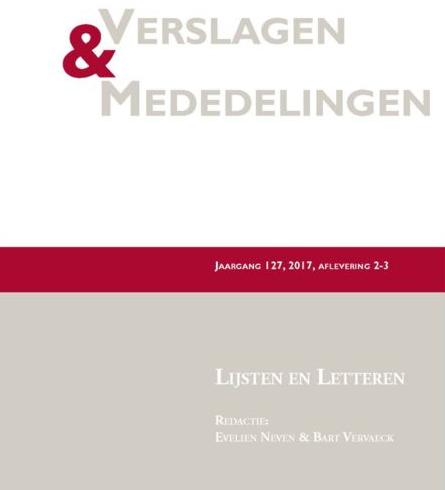Humor? Check. Humor en lijsten in 'Moby-Dick' (1851) en 'Max Havelaar' (1860)
Samenvatting
Dit artikel vergelijkt twee gecanoniseerde werken uit de negentiende eeuw, Herman Melvilles 'Moby-Dick' en Multatuli’s 'Max Havelaar'.
Die twee romans maken creatief gebruik van humor en in beide werken hebben lijsten een belangrijk aandeel in de creatie van die humor. De lijsten maken optimaal gebruik van het spel met herhaling en variatie. Ze creëren niet enkel humor op basis van inhoudelijke en formele elementen, maar ook door de manier waarop ze bijdragen aan de karakterisering. Zowel in 'Moby-Dick' als in 'Max Havelaar' roepen lijsten een bepaald verwachtingspatroon op dat incongruent blijkt met de uiteindelijke leeservaring. Ze realiseren op die manier de humor waarmee 'Moby-Dick' en 'Max Havelaar' consequent geassocieerd worden.
Abstract:
This article compares two nineteenth century canonical novels, Herman Melville’s 'Moby Dick' and Multatuli’s 'Max Havelaar'.
These two novels are characterised by their often humorous tone. Lists play a significant part in the creation of that humour. They cleverly contrast repetition on the one hand with variation on the other hand. They thus not only create humour through means of content-specific or formal elements, but also by contributing to the narrative process of characterisation. In 'Moby-Dick' as in 'Max Havelaar', lists engender certain expectations that ultimately prove incongruent with the reading experience and as such are instrumental in realising the characteristic humour of 'Moby-Dick' and 'Max Havelaar'.
- Auteurs behouden de auteursrechten en geven het tijdschrift het recht van eerste publicatie van het werk onder een Creative Commons Attribution Licentie die anderen het recht geeft het werk te delen onder vermelding van het auteurschap van het werk en de eerste publicatie in dit tijdschrift.
- Auteurs mogen separate, additionele contractuele overeenkomsten aangaan voor het niet-exclusief distribueren van de door het tijdschrift gepubliceerde versie van het werk (bv. plaatsing in een institutionele repository of publicatie in een boek), onder vermelding van de eerste publicatie in dit tijdschrift.
- Auteurs hebben het recht en worden aangemoedigd om hun werk online beschikbaar te stellen (bv. in institutionele repositories of op hun website) voorafgaand aan en gedurende de inzending, aangezien dat kan leiden tot productieve discussies, sneller en meer citaties van het gepubliceerde werk (Zie The Effect of Open Access).


